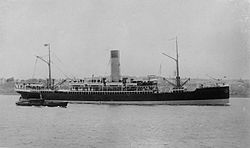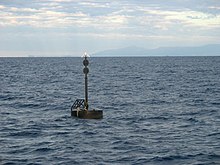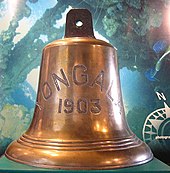Yongala (ship)
|
||||||||||||||||||||
|
||||||||||||||||||||
|
||||||||||||||||||||
|
||||||||||||||||||||
The Yongala was a passenger ship put into service in 1903 by the Australian shipping company Adelaide Steamship Company, which transported passengers , mail and cargo on a regular service between Australian ports such as Adelaide , Sydney , Melbourne and Cairns . On March 23, 1911, the steamer was sunk by a cyclone off Townsville on the east coast of Australia . All 122 passengers and crew were killed. The wreck of the Yongala was only discovered in 1958. The exact circumstances could never be clarified as there were no surviving eyewitnesses. To date, its sinking is one of the largest shipping disasters in Australia.
The ship

Constructed of steel, the Yongala was built by Armstrong Whitworth & Co. Limited on the River Tyne in the English city of Newcastle upon Tyne . She ran on 29 April 1903 by the stack and was completed in October 1,903th According to the tradition of the shipping company , the ship was named after a word from the Aboriginal language . In this case it was yongala , which means “wide water”. The city of Yongala in the Australian state of South Australia was named after this term.
The Yongala was powered by triple expanding steam engines and had a single screw and five steam boilers . Their machines were made by the Wallsend Slipway and Engineering Company. The official maximum achievable service speed was 15.8 knots. At the average cruising speed of 15 knots, 67 tons of coal were consumed per day. A maximum speed of 17 knots was even recorded on numerous crossings. A number of heavy- duty anchor winches and capstans as well as seven cable winches , two steam-powered loading cranes and several derrick cranes were installed on the forecastle, which were supposed to ensure fast loading and unloading of the cargo holds. The Yongala was also provided with electric light for the freight and a vapor-driven steering housing on, cooling devices poop deck provided that the bridge could be controlled from.
The Yongala was registered in Adelaide and carried passengers from Western Australia to the ports of Adelaide, Melbourne and Sydney. From 1906 she was used on the Brisbane - Fremantle route. She was the first ship to cover this 5000 km long distance. Between 1907 and 1911, the ship sailed from Melbourne to Cairns in the winter months, as the Brisbane – Fremantle route was not particularly popular in winter.
The last ride
First stops on the journey
On Tuesday, March 14, 1911, the Yongala laid off in Melbourne under the command of the 62-year-old Captain William Knight for another crossing to Cairns . It was her 99th voyage in Australian waters. Captain Knight had been with the Adelaide Steamship Company for 14 years and was considered a competent and reliable skipper who had never had an accident in his career. There were 72 passengers and 73 crew members on board.
On the morning of March 20, the steamer docked at the Pier Municipal Wharf in Brisbane, where 70 travelers disembarked. After new passengers and cargo were taken on board, an inspection of the ship took place which showed that it was in excellent condition. The continuation of the journey had been delayed, so the Yongala headed for her next stop, Mackay , at top speed .
The Yongala arrived in Mackay on Thursday morning, March 23rd . Passengers disembarked again, others came on board. When the ship cast off again at 1.40 p.m., 49 passengers, 73 crew members and 617 tons of cargo were on board. The Yongala was still in sight when the weather station at Flat Top, near Mackay, received a telegram that a cyclone was raging along the Queensland coast between Townsville and Mackay . The previous year, Australia's first wireless telegraph radio station was set up in Sydney , but so far very few ships have been equipped with such a system. Five hours after casting off in Mackay, the Yongala was spotted by the Dent Island lighthouse keeper on the Whitsunday Islands as she steered straight into the bad weather zone. This was the last known sighting of the steamer.
Disappear
The exact circumstances of the fall of the Yongala could never be clarified. In the northern part of Queensland the strong winds turned from the southeast to the northwest and then came from the northeast. Thus they would have hit the ship's course with full force at a right angle. Although the radius of the area affected by the cyclone was no greater than about 30 km, the cyclone nevertheless left a swath of devastation in the Cape Upstart area. The delay of the Yongala did not cause much excitement at first. However, when three other ships that were in the same area and had sought shelter from the storm arrived at their destination ports and the Yongala did not, they were alarmed. The ship was reported missing on March 26th. The Prime Minister of the State of Queensland, Digby Denham , used all available forces to search for the ship, including the police and seven coast guard ships .
From Hinchinbrook Island to Bowen, there have been reports of debris and wreckage being washed ashore, but the ship itself and the people on it have disappeared. A week after the Yongala disappeared , hope of finding survivors was given up. No bodies were found either. Only the carcass of the racehorse Moonshine, which was to be brought to Townsville on board the Yongala , was recovered. It was washed into Gordon Creek Bay. Since no lifeboats were found either , it was believed that the end of the Yongala had come very quickly and unexpectedly.
The disappearance of the steamer was followed by many theories and speculations about what might have happened to the ship. Some believed that the Yongala machines between Whitsunday Passage and Cape Bowling Green had been damaged by the cyclone; possibly the anchors had also been torn loose, whereby the ship was stuck and its broadside was exposed to the violent gusts. Under certain circumstances the Yongala collided with an underwater rock between Flinders Passage and Keeper Reef or ran aground.
Aftermath
The Queensland government offered a reward of 1000 Australian pounds for clues leading to the location of the Yongala . However, after no indications or statements were received, this offer was dropped. In the south-eastern regions of Australia, many communities and cities commemorated the misfortune, and the Yongala Distress Fund was set up, the proceeds of which went to the relatives of the Yongala victims. A sum of 900 Australian pounds, also raised through this fund, went to the Queensland Shipwreck Society in September 1914.
On June 8, 1911, the investigation into the accident by the Marine Board of Queensland was opened in Brisbane. It was completed on June 20th. Since no surviving eyewitnesses could be questioned, the investigation was essentially limited to the course, safety, stability and seaworthiness of the Yongala and the question of whether Captain Knight had acted carefully enough and was generally a reliable commander. Chief Engineer Adamson testified that all tests and drills conducted after the ship was completed met Adelaide Steamship Company's requirements and that the Yongala had been proven to be safe and seaworthy in eight accident-free years of service. The committee was satisfied that the ship met the required standards.
The committee continued to scrutinize the captain's competencies. To this end, witnesses were heard and asked questions about his skills and character. All interviewees described Captain Knight as an experienced and careful skipper. The Marine Board concluded that " after the last sighting by the Dent Island lighthouse keeper, the Yongala had evaded the human eye and knowledge to add to the mysterious incidents at sea".
The committee was also confirmed in its opinion that shipping and navigation on the Queensland coast were affected by the annual hurricane season from December to April and that no matter how safe a ship and how professional a captain may be, it still does an accident can occur. In the years after the Yongala disappeared , ghost rumors emerged about the ship. A ghost ship that looked like the Yongala is said to have been seen regularly between Bowen and Townsville.
Discovery of the wreck
In the decades that followed, the fate of the Yongala was largely forgotten. In 1943, a minesweeper ran eleven miles east of Cape Bowling Green on what was then mistaken for a sandbar . After the war, the site was examined by the research vessel Lachlan , which belonged to the Royal Australian Navy . The Lachlan arrived in June 1947 and searched the area with an echo sounder and other equipment. She found that at the bottom of the shallow water there was an object about 91 meters long, which may have been the remains of a steamship. Apart from the Yongala , there was no other reported wreck in the area . However, the Navy did not research the wreck further and therefore did not find out its identity.
In 1958, the two divers Don Macmillan and Noel Cook became interested in the Yongala and made a reconnaissance trip with a research team to the as yet unidentified wreck. The crew hid a shellfish-encrusted safe from the interior of the ship that only contained silt . The only usable clue was the safe's serial number - 9825W. The find turned out to be a Chubb brand safe and was sent to the manufacturers in London to see which ship the safe had been taken to. The answer came only in 1961, but it was hopefully positive. It was the safe from the Paymaster office of the Yongala .
The wreck of the Yongala is about 30 meters deep at the coordinates 19 ° 18 ′ 27 ″ S , 147 ° 37 ′ 31 ″ E , 35 km northeast of Ayr and 100 miles east of Townsville. It is located off Cape Bowling Green in the Coral Sea within the Great Barrier Reef Marine Park . Despite a list of 60 to 70 degrees to starboard , it is in a relatively undamaged condition. It is still a popular diving destination to this day.
Death at the Yongala
On the morning of October 22, 2003, the newly married Americans Tina and David Gabriel Watson set out to dive the Yongala. In contrast to Gabriel, Tina was not very experienced in diving. At around 10:45 am, the two of them descended towards Yongala. They followed a group of six divers led by an instructor . About five minutes later, the instructor found Tina Watson motionless on the bottom at a depth of around 28 meters. All attempts at resuscitation by two doctors present on the boat failed, so Tina Watson was pronounced dead 40 minutes later. While on the submersible, Gabriel Watson is accused of murdering Tina. Because he contradicted himself several times in later police interrogations, the suspicion that he had murdered his wife - by turning off the air briefly - was reinforced . After extensive investigations by specialists, Gabriel Watson was not charged in Queensland until June 20, 2008. On July 18, 2009, the Queensland Supreme Court sentenced him to 12 months in prison for manslaughter . No criminal intentions could be proven, but the obvious failure to provide any help to save his wife's life.
See also
literature
- Max Gleeson. Townville's Titanic . Turton & Armstrong, Sydney (1987)
- Holthouse. Yongala Vanishes . In: Cyclone , pp. 59-66, Rigby, Adelaide (1971)
Web links
- Illustrated report on the disappearance of the Yongala (with passenger list from the last trip)
- Summary in short bullet points
- The Yongala as a diving destination ( Memento from January 25, 2014 in the Internet Archive )
- Main page of www.yongaladive.com, an Australian diving website
- The location of the Yongala wreck
Footnotes
- ↑ Yongala dive death now a murder trial (English). Retrieved May 23, 2011 .
- ↑ a b c d Killed while diving on your honeymoon? Retrieved May 23, 2011 .
- ↑ The Scuba Murder Case Police Transcript (English). Retrieved May 23, 2011 .
- ↑ Yongala dive death inquest. (No longer available online.) Formerly in the original ; Retrieved May 23, 2011 . ( Page no longer available , search in web archives )
- ↑ Doubts on diving death appeal (English). Retrieved May 23, 2011 .


